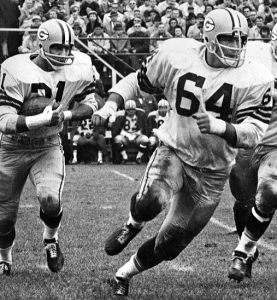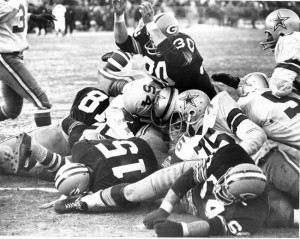Pro Football Hall of Fame Gets a Bit Closer to Legitimacy

Nearly 50 years after retiring from the NFL, Jerry Kramer (#64) has finally been selected for the Pro Football Hall of Fame.
For me and likely many other long-time lovers of the history of pro football, the relationship with the Pro Football Hall of Fame has always been a messy one.
I have enjoyed the great fortune of visiting the Pro Football Hall of Fame multiple times over the years, including taking my kids to Canton in 2015. The museum is a wonderful place to see, recall and learn about the many great moments, players and teams that have been part of the nearly 100 year history of the NFL.
However, while the Hall of Fame was created to be a historical archive to tell the story of professional football, over the years it has become more associated with the players specifically enshrined as Hall of Famers.
That is where for me the relationship starts to get a bit challenging.
While most of the 310 men who have been enshrined in the Hall of Fame through 2017 are unquestionably deserving, the process in which players are chosen has often been an uneven process in which some former players, coaches and administrators are quickly recognized while others with similar credentials either wait for many years or are totally omitted.
Made up of sports media professionals, the Hall of Fame selection committee has a long history of personal vendettas and bias.
Longtime committee member Paul Zimmerman reportedly said that Ken Stabler would never get inducted in his lifetime and sure enough Stabler was not inducted until the year after he died in 2015.
My greatest frustration with the Hall of Fame selection committee stems from their regular practice of making players and coaches who clearly have Hall of Fame credentials wait extended periods of time before being inducted.
Among the clearly deserving Hall of Famers who have been forced to wait beyond their initial year of eligibility were Fran Tarkenton, Shannon Sharpe, Derrick Thomas, Hank Stram, Willie Lanier, Tom Mack and Willie Wood.
The one position that has historically been treated with limited respect by the selection committee is position of wide receiver. Entering 2018, 25 modern era wide receivers have been inducted into the Hall of Fame, but only four of them (Jerry Rice, Raymond Berry, Paul Warfield and Steve Largent) were selected in their first year of eligibility.
Of the 15 people who have been Hall of Fame Finalists at least eight times, five were wide receivers. Of those 15 players, there is now only one (Bob Kuechenberg) who is still waiting for enshrinement in the HOF.
My frustration is that once a player retires, his statistics and performance resume doesn’t change. So why does it often take decades after retirement for a player to finally receive recognition from the Hall of Fame?
One problem that is finally being worked out after many years is dealing with the glut of deserving Hall of Famers who were kept out of Canton during a period in which the voters often chose only the minimum number of inductees.
Between 1970 and 2005 the Hall of Fame welcomed two classes of only three people and 15 with only four members. This resulted in a huge glut of deserving players, especially stars from the 1970s and 1980s, who were pushed back behind other deserving players from previous generations during their prime years on the ballot.
Given that players are eligible for the primary media selection process only for the first 25 years after their retirement (five year waiting period and then 20 years on the ballot), this meant quite a few players who probably should have been in the conversation were not even making it to the final ballot. It also has meant that former players who eventually were inducted missed out on decades of recognition and celebration before finally being honored late in life or in a number of cases after they had passed away.
Fortunately, since 2006 the committee has been much better at increasing the number of players selected each year. Each class since 2006 has included at least six people and most have been seven or eight former players, coaches and administrators.
Perhaps the hardest thing for football history lovers like myself is that in many years when the selections have been announced, it has been easy to point to multiple players who are not in the Hall of Fame, but had career resumes that were as good or better than many of those receiving induction that year.
Depending on your favorite team or era, all football history lovers can quickly and clearly illustrate why a specific player deserves to be in the Hall of Fame. Among those I have seen mentioned recently in Classic Football Lovers Facebook sites include Tommy Nobis, Cliff Branch, Chuck Howley, Otis Taylor, Drew Pearson, Cliff Branch, Randy Gradishar, Harvey Martin and Coy Bacon, just to name a few.
However, there has been for several decades one former player whose Hall of Fame omission was most puzzling and placed him at the top of all lists of players most deserving of being in the Hall of Fame.
Former Green Bay Packers great Jerry Kramer was so well thought of when the 50th Anniversary of the NFL was held in 1969 that he was selected as one of two offensive guards on the 50th Anniversary team.
He was first chosen as a Hall of Fame Finalist in 1974 and was a finalist nine times between 1974 and 1987. As the years went by without Kramer getting the call, the conversation became that Kramer was being hampered by the fact that many of his former teammates on the great Green Bay teams of the 1960s were already inducted and the committee was reluctant to induct too many former Packers.
However, eventually after all the former Packers with similar resumes to Kramer were in and then other former Packers were still getting inducted, that reason no longer seemed valid.
What became harder to understand was that over time other offensive linemen from the same era in which Kramer was a five time first team All-Pro started to get inducted while Kramer continued to wait.
Once Kramer was no longer eligible for the general election and would have to be selected through the veteran’s process it became even harder for most football history lovers to understand.
Kramer was a veteran’s committee finalist in 1997, but did not receive enough support to be inducted. Since 1997, 16 of the inductees chosen through the veteran’s committee had never previously been a Hall of Fame finalist.
In recent years as the obvious snub against Kramer continued, it has been increasingly difficult to fully embrace the Hall of Fame.
So, since Kramer was announced last summer as one of the two Veteran’s committee selections as finalists for 2018, football history lovers across the country have seemingly been holding our collective breath hoping that this would finally be the year for one of the all-time greats.
I think most of us believed that the committee would not have picked Kramer as a finalist if this wasn’t going to be the year. He is now 82-years-old and putting him on the ballot one more time without choosing him for enshrinement would be as cruel a treatment as could ever be imagined.
However, since most of us couldn’t really understand why he wasn’t inducted decades ago, we knew his enshrinement wasn’t a guarantee.
Well, we can now all exhale. Earlier tonight Kramer received the “knock on his door” and was selected as one of eight members of the 2018 class for the Pro Football Hall of Fame.
Part of me is frustrated that it didn’t come sooner and Kramer will not get to be part of Hall of Fame reunions for decades the way he would have been had he been chosen when he should have been during the 1970s.
However, since that is something that cannot now be rectified, I am just glad that Kramer will finally get his Hall of Fame bust and moment in the sun during the 2018 Induction Ceremony.
Many of the younger NFL fans will note 2018 as the class of Ray Lewis, Randy Moss, Brian Urlacher and Terrell Owens, but for me, the highlight of the Class of 2018 will unquestionably be the induction of Jerry Kramer.
Editor’s Note: Congratulations to all eight members of the Hall of Fame Class for 2018: Bobby Beathard, Robert Brazile, Brian Dawkins, Jerry Kramer, Ray Lewis, Randy Moss, Brian Urlacher and Terrell Owens.














